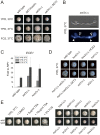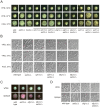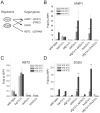The Set3/Hos2 histone deacetylase complex attenuates cAMP/PKA signaling to regulate morphogenesis and virulence of Candida albicans
- PMID: 20485517
- PMCID: PMC2869326
- DOI: 10.1371/journal.ppat.1000889
The Set3/Hos2 histone deacetylase complex attenuates cAMP/PKA signaling to regulate morphogenesis and virulence of Candida albicans
Abstract
Candida albicans, like other pleiomorphic fungal pathogens, is able to undergo a reversible transition between single yeast-like cells and multicellular filaments. This morphogenetic process has long been considered as a key fungal virulence factor. Here, we identify the evolutionarily conserved Set3/Hos2 histone deacetylase complex (Set3C) as a crucial repressor of the yeast-to-filament transition. Cells lacking core components of the Set3C are able to maintain all developmental phases, but are hypersusceptible to filamentation-inducing signals, because of a hyperactive cAMP/Protein Kinase A signaling pathway. Strikingly, Set3C-mediated control of filamentation is required for virulence in vivo, since set3Delta/Delta cells display strongly attenuated virulence in a mouse model of systemic infection. Importantly, the inhibition of histone deacetylase activity by trichostatin A exclusively phenocopies the absence of a functional Set3C, but not of any other histone deacetylase gene. Hence, our work supports a paradigm for manipulating morphogenesis in C. albicans through alternative antifungal therapeutic strategies.
Conflict of interest statement
The authors have declared that no competing interests exist.
Figures









Similar articles
-
DYRK-family kinases regulate Candida albicans morphogenesis and virulence through the Ras1/PKA pathway.mBio. 2023 Dec 19;14(6):e0218323. doi: 10.1128/mbio.02183-23. Epub 2023 Nov 28. mBio. 2023. PMID: 38015416 Free PMC article.
-
The Proteasome Governs Fungal Morphogenesis via Functional Connections with Hsp90 and cAMP-Protein Kinase A Signaling.mBio. 2020 Apr 21;11(2):e00290-20. doi: 10.1128/mBio.00290-20. mBio. 2020. PMID: 32317319 Free PMC article.
-
A histone deacetylase adjusts transcription kinetics at coding sequences during Candida albicans morphogenesis.PLoS Genet. 2012;8(12):e1003118. doi: 10.1371/journal.pgen.1003118. Epub 2012 Dec 6. PLoS Genet. 2012. PMID: 23236295 Free PMC article.
-
Histone deacetylase-mediated morphological transition in Candida albicans.J Microbiol. 2015 Dec;53(12):805-11. doi: 10.1007/s12275-015-5488-3. Epub 2015 Dec 2. J Microbiol. 2015. PMID: 26626350 Review.
-
To each its own: Mechanisms of cross-talk between GPI biosynthesis and cAMP-PKA signaling in Candida albicans versus Saccharomyces cerevisiae.J Biol Chem. 2024 Jul;300(7):107444. doi: 10.1016/j.jbc.2024.107444. Epub 2024 Jun 4. J Biol Chem. 2024. PMID: 38838772 Free PMC article. Review.
Cited by
-
Transcription factor Efg1 shows a haploinsufficiency phenotype in modulating the cell wall architecture and immunogenicity of Candida albicans.Eukaryot Cell. 2012 Feb;11(2):129-40. doi: 10.1128/EC.05206-11. Epub 2011 Dec 2. Eukaryot Cell. 2012. PMID: 22140230 Free PMC article.
-
Efg1 Controls caspofungin-induced cell aggregation of Candida albicans through the adhesin Als1.Eukaryot Cell. 2011 Dec;10(12):1694-704. doi: 10.1128/EC.05187-11. Epub 2011 Oct 28. Eukaryot Cell. 2011. PMID: 22037180 Free PMC article.
-
Candida albicans hyphal initiation and elongation.Trends Microbiol. 2014 Dec;22(12):707-14. doi: 10.1016/j.tim.2014.09.001. Epub 2014 Sep 25. Trends Microbiol. 2014. PMID: 25262420 Free PMC article. Review.
-
Synergistic and antagonistic effects of immunomodulatory drugs on the action of antifungals against Candida glabrata and Saccharomyces cerevisiae.PeerJ. 2018 Jun 13;6:e4999. doi: 10.7717/peerj.4999. eCollection 2018. PeerJ. 2018. PMID: 29915703 Free PMC article.
-
On and Off: Epigenetic Regulation of C. albicans Morphological Switches.Pathogens. 2021 Nov 11;10(11):1463. doi: 10.3390/pathogens10111463. Pathogens. 2021. PMID: 34832617 Free PMC article. Review.
References
-
- Odds FC. London: Baillière Tindall; 1988. Candida and Candidosis: A Review and Bibliography.
-
- Rooney PJ, Klein BS. Linking fungal morphogenesis with virulence. Cell Microbiol. 2002;4:127–137. - PubMed
-
- Gow NA, Brown AJ, Odds FC. Fungal morphogenesis and host invasion. Curr Opin Microbiol. 2002;5:366–371. - PubMed
-
- Brown AJ, Gow NA. Regulatory networks controlling Candida albicans morphogenesis. Trends Microbiol. 1999;7:333–338. - PubMed
-
- Ernst JF. Transcription factors in Candida albicans - environmental control of morphogenesis. Microbiology. 2000;146 (Pt8):1763–1774. - PubMed
Publication types
MeSH terms
Substances
LinkOut - more resources
Full Text Sources
Medical
Molecular Biology Databases

